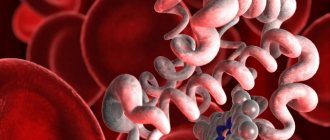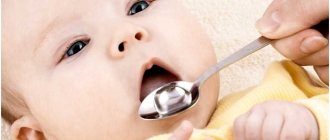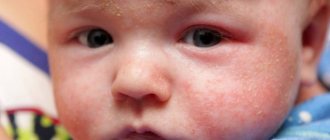Hemoglobin is a protein that contains iron and carries oxygen from the lungs to the organs. A pathology in which the hemoglobin level falls below normal is called anemia
Anemia is accompanied by weakness, headaches, tinnitus, decreased appetite and sleep disturbances. The most vulnerable category of patients with anemia are children of early and school age. Schoolchildren get tired quickly, learn more slowly and remember less information, do not get enough sleep and become irritable. With severe anemia, dystrophic changes occur in the heart muscle - this leads to disruption of the heart and circulatory failure.
Hemoglobin levels can be raised with medications and foods. However, the choice of treatment depends on the type of anemia and its cause. In this article we will answer the questions: what is the norm for hemoglobin in children, why does it decrease, what foods does it contain, and how to prevent anemia in children.
Hemoglobin - what is the norm for a child
Each blood indicator has a norm, including hemoglobin. The World Health Organization gives the following hemoglobin standards for children:
- newborns up to 2 weeks of life - not lower than 150 g/l;
- children from 2 to 4 weeks of life - 120 g/l and above;
- children aged 6 to 59 months - 110-140 g/l;
- children aged 5 to 11 years - 115-140 g/l;
- children aged 12 to 14 years - 120-150 g/l;
- children and adults over 15 years old - 130-160 g/l.
Anything below is considered mild (below normal, but above 90 g/l), moderate (70-90 g/l) or severe (below 70 g/l) anemia. Each of the three degrees of severity has its own symptoms and treatment tactics.
Sources of iron in baby food
Breastfed babies receive the required amount of iron from their mother's milk, while bottle-fed babies receive the necessary amount of iron from a balanced infant formula.
Tiunova Elena
K.M.N., pediatrician of the highest category, nutritionist
“By the age of 3–4 months, the supply of iron created during the period in the womb decreases in the body of infants. There comes a period when the child does not have enough nutrients (including iron) supplied only with breast milk or formula.”
Therefore, it is important to introduce complementary foods to the child in a timely manner (from 4 to 6 months) using industrially produced products (especially cereals and pureed meat fortified with vitamins and minerals) to ensure the supply of iron and to prevent its deficiency.
It must be remembered that iron is best absorbed from meat. Also, for sufficient iron intake into the body, food must contain enough protein and vitamins. Vegetables and fruits contain small amounts of iron, but ascorbic acid in their composition improves its absorption.
Why does a child have low hemoglobin?
Reasons for decreased hemoglobin levels in children: blood loss, insufficient blood production in the bone marrow and increased destruction of red blood cells.
Causes of low hemoglobin levels:
- malignant (cancerous) tumors;
- anemia due to vitamin deficiency;
- Iron-deficiency anemia;
- aplastic anemia;
- cirrhosis of the liver;
- Hodgkin's lymphoma;
- hypothyroidism;
- chronic kidney disease.
The first reason is blood loss. It can be acute and chronic. Typically, hemoglobin levels decrease several hours after the onset of blood loss. Chronic blood loss leads to anemia when the body does not have enough iron to produce new red blood cells. Examples of blood loss: gastrointestinal bleeding from an ulcer, bowel or kidney cancer, bone fractures, recent surgery, heavy menstruation in teenage girls.
The second reason is low blood production (erythropoiesis deficiency). In this case, a decrease in hemoglobin levels is caused by infections, hereditary pathologies, kidney diseases, copper and folic acid deficiency, vitamin B1 deficiency and malabsorption.
In addition, insufficiency of erythropoiesis occurs in myelofibrosis and osteomyelosclerosis. Myelofibrosis is a pathology in which fibrous tissue gradually replaces hematopoietic tissue in the bone marrow. Osteomyelosclerosis is the replacement of connective tissue with hematopoietic tissue. These disorders usually occur in cancers: lymphoma, multiple myeloma, chronic myelogenous leukemia.
The third reason is increased destruction of red blood cells. Occurs with pathological enlargement of the spleen, taking certain medications (quinine, quinidine, penicillin, ticlopidine), hemolytic-uremic syndrome, Epstein-Barr viral infection (human herpes virus type 4), malaria, botulism, tetanus, congenital heart valve defects, spider bites , insufficient levels of phosphates in the blood.
Other reasons for low hemoglobin levels in the blood:
- inflammatory diseases of the small and large intestine;
- insufficient intake of iron into the child’s body;
- chronic kidney disease;
- prematurity of the child;
- late or early umbilical cord ligation;
- Giardiasis is a parasitic intestinal disease;
- Helicobacter pylori infection and atrophic gastritis.
There are groups and risk factors that can lead to low hemoglobin levels and the most common type of anemia, iron deficiency:
- if the child was born with low body weight;
- children born from multiple pregnancies;
- children who did not receive enough iron through breastfeeding and formula milk;
- children who often suffer from infectious diseases;
- children with allergies;
- malnutrition, poverty.
A decrease in hemoglobin levels is not always regarded as a pathology. Children, especially teenagers, need a lot of iron for their body development. Due to the rapid growth of the microelement, there may be a temporary lack of microelement, so the level of hemoglobin in the blood decreases. This is especially true for children and adolescents who are actively involved in sports. They may develop "athlete's anemia." By eating foods high in iron, the deficiency is eliminated.
Other factors of iron deficiency
Sometimes it happens that iron enters the child’s body in sufficient quantities, but the baby nevertheless develops iron deficiency.
It's possible:
- in case of impaired absorption of nutrients in the gastrointestinal tract due to its diseases;
- lack of vitamin C;
- helminthic and parasitic infestations.
All these factors prevent the child’s body from fully absorbing iron, which becomes the cause of its deficiency.
With iron deficiency, a disease develops - iron deficiency anemia. In this case, it is impossible to compensate for the lack of iron with food and it is necessary to prescribe iron supplements.
How does low hemoglobin manifest?
Signs of low hemoglobin levels manifest themselves in different ways. They can be divided into groups of symptoms: asthenic, epithelial, cardiovascular, muscular and secondary immunodeficiency syndrome.
Asthenic symptoms are manifested by increased fatigue, irritability, emotional instability, lethargy, and absent-mindedness. Children sleep poorly, eat little or do not want to eat at all. Children may complain of tinnitus, dizziness and headaches.
Epithelial symptoms: children have a pale face, areas of the legs and nails, pale ears and oral mucosa. The skin is dry and often flakes. Hair becomes brittle and may fall out. “Sticks” appear in the corners of the mouth. The child may complain of a burning tongue and dry mouth, difficulty swallowing and nausea.
Cardiovascular symptoms: increased heart rate, rarely shortness of breath. Sometimes the child complains of pain in the heart area.
Muscle symptoms: muscles weaken, the child quickly gets tired of simple activities, and may involuntarily defecate day and night due to weakness of the sphincter muscle.
Secondary immunodeficiency syndrome is manifested by the fact that the child often suffers from colds. He often experiences otitis media, pneumonia and intestinal infections. Rare symptoms of low hemoglobin levels are an increase in body temperature to 38 0C, red-tinged urine, swelling on the face.
Symptoms of low hemoglobin in infants
How can you tell if your baby has low hemoglobin? The baby begins to eat poorly and loses weight. He begins to experience delays in physical development. The main symptoms of a decrease in complex protein compounds include:
- baby's susceptibility to frequent colds and respiratory diseases;
- constant drowsiness;
- rapid fatigue;
- white spots on the nails, peeling nails;
- pale dry skin;
- the skin may become yellowish;
- bruises under the eyes;
- abnormal stool, which may include diarrhea or constipation;
- cardiopalmus;
- migraines and dizziness;
- elevated temperature;
- poor appetite and frequent regurgitation.
In some cases, cracks are observed on the feet and palms. A child puts inedible things in his mouth, although this is not an indicator for small children; this is how they learn about the world. They notice developmental deviations; the baby could roll over on his tummy on his own, or perform some other new actions, and then suddenly stops. An enlarged liver or spleen is felt upon palpation.
In rare cases, there may be loss of consciousness, heart murmurs, and low blood pressure.
The mother needs to figure out why the baby has low hemoglobin in the blood. If a newborn is sick, then the reasons for the poor level of hemoglobin in red blood cells lie in the pathology of pregnancy. When a baby has low hemoglobin at 1 month, this indicates the development of the problem during the prenatal period. A baby's hemoglobin may also be lower than normal due to a difficult birth.
Low hemoglobin - what to do
If you notice any of the symptoms described above in your child, contact your pediatrician. He will examine the child, listen to heart sounds, and give a referral for a general and biochemical blood test, which can confirm a reduced hemoglobin level. After the doctor has diagnosed anemia and identified its cause, the child is prescribed treatment and diet.
Depending on the cause of anemia, the doctor prescribes different treatments. For example, in case of deficiency anemia (when the body does not receive enough nutrients), medications are prescribed to compensate for the deficiency: B vitamins or iron supplements. For B12-deficiency anemia, the doctor prescribes vitamin B12 (cyanocobalamin), and in severe cases, a transfusion of red blood cells is indicated. For anemia of a chronic disease, iron supplements and recombinant erythropoietin are prescribed.
Often, anemic syndrome manifests itself in other diseases, for example, with kidney pathology, infections or disorders of the gastrointestinal tract. In this case, the doctor prescribes treatment for the underlying disease, which will restore the level of hemoglobin in the blood.
Causes of anemia in children
The reason for the high prevalence of anemia in children lies in the imperfection of hematopoietic mechanisms. These subtle processes can be influenced by the most insignificant factors that will not cause illness in an adult. In addition, children grow and develop in leaps and bounds and require increased amounts of nutrients during periods of peak growth. This can lead to a decrease in hemoglobin levels.
There are a number of the most common causes of anemia in newborns:
- severe pregnancy of the mother: bleeding, placental abruption, hematomas, threats of miscarriage, infectious diseases. Especially in the period 28–32 weeks, when intensive transfer of iron from the mother’s body to the fetus begins;
- prematurity;
- multiple pregnancy;
- poor mother's diet;
- high blood loss during childbirth;
- early or late umbilical cord ligation;
- bleeding from the umbilical cord as a result of improper treatment.
Other common causes of anemia in children of any age include the following:
- unbalanced diet. It leads to the fact that the body does not receive a sufficient amount of B vitamins, iron, and substances that promote its full absorption (vitamin C). Anemia can develop in newborns fed with unadapted milk formulas, goat milk, etc.;
- chronic bleeding. Bleeding gums, frequent nosebleeds, stomach diseases, etc. lead to blood loss;
- allergic reactions, diathesis accompanied by the formation of exudate, neurodermatitis;
- infectious diseases (tonsillitis, infectious mononucleosis, etc.);
- mycoses (fungal diseases);
- helminthic infestations, parasitosis, etc.
Pathological causes of anemia in children include hemolytic disease, bone marrow failure, and abnormal hemoglobin synthesis.
A doctor can understand the reasons and prescribe a suitable treatment regimen. It is important to contact him if you notice symptoms as soon as possible.
Foods that increase hemoglobin
Food can increase hemoglobin levels in iron deficiency anemia. For other types (dyshematopoietic, posthemorrhagic, hemolytic, B12-deficiency anemia), specific treatment with drugs, blood transfusions or surgery is required.
List of products that increase hemoglobin:
- tahini halva contains more than 50 mg of iron per 100 g of product. Halva also contains vitamins E, B, phosphorus, zinc and calcium. Some of these substances improve the absorption of iron in the digestive tract;
- meat products: beef, liver, tongue, rabbit, veal. The iron content in these products ranges from 5 to 30 mg per 100 g of product;
- dried mushrooms: they contain up to 30 mg of iron per 100 g of finished product;
- seafood: squid, shrimp, clams, caviar, scallops. They contain up to 30 mg of iron per 100 g of product;
- wheat bran contains up to 15 mg of iron per 100 g of product;
- seaweed contains up to 12 mg of iron per 100 g of product;
- beets - 30 mg of microelement per 100 g of product;
- pomegranate - up to 30 mg of iron per 100 g of product.
It is recommended to add foods enriched with cobalt and manganese to your daily diet: squid, tuna, cod, catfish, flounder, pike, oat bran, rice flour. These products help the absorption of iron and accelerate the production of hemoglobin. It is also recommended to add medicinal herbs to food: stinging nettle, tripartite string, infusion of rose hips, strawberries, rowan tea, black currants.
Blood iron values
Serum iron levels vary significantly throughout the day, reaching a maximum in the morning (difference up to 40%). The indicator values depend on gender and age. Newborns experience a drop in iron levels within a few hours of birth.
Average iron levels in women are lower than in men, but in both men, iron levels in the blood decrease with age. Iron concentration in women is also associated with the menstrual cycle (the highest level is in the luteal phase, the lowest level is after menstruation).
Lack of sleep and stress, severe physical activity also cause a decrease in this indicator. During pregnancy, the iron content in the body decreases, especially in the second half (the increased need for iron during this period is associated with the formation of an iron depot in the fetus).
Normal blood iron levels:








